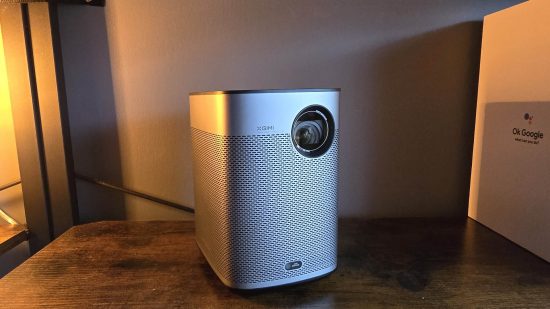Our Verdict
The XGIMI Halo+ is an incredible mini projector. Its fantastically small form factor and battery life give it unparalleled portability. Combine that with a broad array of exceptional quality-of-life tech, in the form of autofocus, keystone, leveling, and object detection, plus some serious clout on the image quality front, and this humble little thing might be the best 1080p projector out there right now, regardless of whether you plug it in or not. Despite a Game Boost Mode though, latency is a little slow for serious gaming.
- Exceptionally easy setup
- Affordable price point
- Great image quality
- Lag noticeable over HDMI
- Could be considered dim
The XGIMI Halo+ portable projector is awesome. That’s a heavy statement to make in the first sentence, but it deserves that accolade. Portable projectors have been around for some time, but they’ve been mediocre at best.
Typically, you get miserable battery life, poor image quality, non-existent brightness, and an eye-watering price tag. Without a doubt, they’re designed predominantly to project corporate spreadsheets and PowerPoint demos, rather than the latest blockbuster, AAA Netflix series, or the best PC games.
And that’s where the XGIMI Halo+ comes in. Sliding stealthily under the radar, as perhaps, one of the best gaming projectors out there for casual users. I’ve been testing screens for around nine years or so, and I’ve worked behind the scenes with brands developing some epic gaming products in my time too, and I can say that the Halo+ is the real deal.
Let’s talk price first. You can pick up the Halo+ in the US for around $850 (it’s often at $650 on sale), or in the UK for about £750. That doesn’t sound cheap, but it’s a bargain compared to some of the best gaming projectors.
Why you can trust our advice ✔ At PCGamesN, our experts spend hours testing hardware and reviewing games and VPNs. We share honest, unbiased opinions to help you buy the best. Find out how we test.
Specs
| Max. resolution | 1920 x 1080 |
| Max. refresh rate | 60 fps |
| Life expectancy | Up to 25,000 hours |
| Latency | 26.5ms (Game Mode) |
| Connectivity | 1x HDMI, 1x USB |
| Wireless | 2.4/5G Wi-Fi, Bluetooth |
| Dimensions | 172 x 114 x 145 mm |
| Weight | 1.6 kg |
Design
The Halo+ has an incredibly small form factor, certainly for a projector. Out of the box it measures 172 x 114 x 145mm and comes in at around 1.6kg total weight. Material choice is pretty stellar too, the external housing comes in a nice satin metallic finish, complete with perforations all around, helping with airflow and letting those Harmon Kardon speakers produce top-quality audio. The rear of the Halo+, where you’ll find the I/O, similarly has some pretty expansive ventilation for the rear exhaust fan.
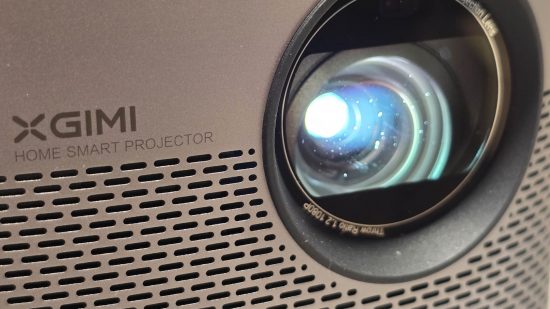
For I/O, there’s not a huge amount here in comparison to something like the Acer Predator GD711, but it’s still got plenty, especially given the unique selling point being portability. You get one HDMI port, one USB 2.0 port, DC power in, a 3.5mm audio out (primarily for headphone use), and a power button.
The top of the unit is finished in black plastic. Here you’ll find a power LED, plus and minus volume touch controls, and a play/pause touch control. Flip over the Halo+ and you’re greeted with a fairly hefty rubberized base, perfect for muting any unwanted vibrations from the unit, alongside an adjustable bracket/foot that you can use to alter the angle of the projector manually. There’s a thread to mount it to the ceiling if you desire.
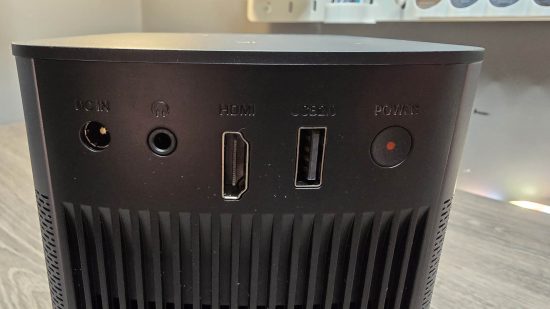
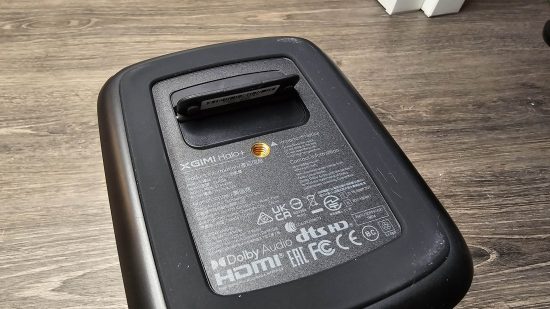
XGIMI has also included a decent remote with the Halo+ as well, with Google smart speaker support, along with directional control, settings, source support, and more impressively a switch that allows you to use the +/- controls to adjust either volume or focus depending on what you set it to.
Features
The Halo+’s baseline specs aren’t exactly super exciting admittedly. The modern display world is littered with far superior technology as far as imagery is concerned. Some of the best gaming monitors out there, pack in 4K resolutions, high refresh rates, OLED panels, you name it. The Halo+, however, is somewhat limited in the fact it can only manage 1080p at 60 fps.
It’s only when you dive into the weeds a little and start using this thing that you truly begin to understand just how incredible a projector it is. Even with that somewhat limiting 1080p 700 lumens resolution. As standard it comes with an absolute ton of built-in quality-of-life features that blow away the competition. Certainly at this price point. Intelligent Screen Alignment and Auto Keystone Correction allow it to automatically adjust its lens angle regardless of how you position it, to get a completely square display, on whatever surface you point it at.
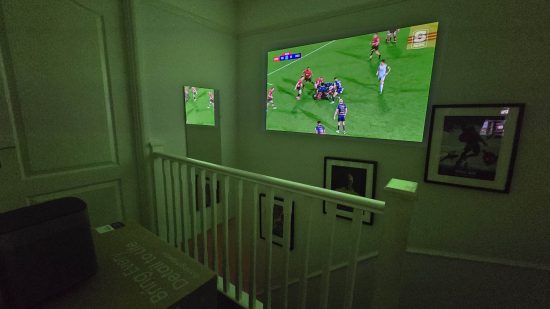
Intelligent obstacle avoidance, then looks for anything on that surface (such as a picture frame), and then adjusts the frame size so your image isn’t intersecting it, and auto-focus, does, as you’d expect, automatically dialing in the lens to ensure focus is crystal clear regardless of distance. If you’re taking this out and about, and want something that’ll set itself up lickety-split and look great when it’s done the Halo+ can handle that and more.
The Halo+ also comes with Android TV built in as standard. There are no weird dongles or widgets that need adding like with the X3100i, it’s just built-in, works, and makes the initial setup super easy. That’s particularly true if you’ve got an Android smartphone as you can transfer all your settings, including WiFi passwords straight over.
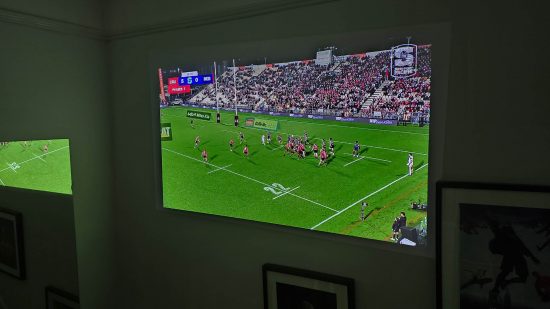
Performance
I spent the last week testing the Halo+ in different environments. I used it against projection screens, on grey walls in my home, in the hallway, at work. You name it, I took it all over the place, to put that portability argument to the test. I can safely say that, despite its 700 ISO lumens brightness, not once was I particularly disappointed with its overall projection quality. Yes, you will get better color accuracy on a white wall, but even on some of the darkest surfaces, plugged in, this thing smashes it when it comes to just how bright and vibrant its colors are.
Image quality at 70 inches was crisp and clear, even at 1080p. Of course, dark colors did suffer, certainly compared to a more traditional display, or an OLED device, but there’s only so much you can get away with when projecting light. It’s that adaptability that really impressed me, however. I took the Halo+ out into my hallway, positioned it at an Angle to the wall I was projecting on, and watched as its tools automatically calibrated the projection to the slightly off-white painted wall, after being used on a traditional screen just moments before.

You can of course, manually adjust those settings after the fact, and I did need to alter some of them depending on the angle (the auto-calibration can only handle up to a 40-degree offset), otherwise it was just an incredible experience, made all the better by that crisp color accuracy and display.
What was less great however was the lag. Although the Android TV apps work flawlessly, running anything over the HDMI was problematic, certainly without game mode enabled (which only turns on if it detects the correct console, not a laptop or a PC). If you’re used to something like Corsair’s Xeneon 27QHD144 OLED it can be an incredibly jarring experience. It felt like there was around a ⅓ of a second delay from moving the mouse and the cursor moving on the desktop, or the button press actuating on screen.
If you intend to game on this, well it’s certainly worth bearing in mind that you’ll need to reign in your expectations. Competitive PvP eSports and things of that ilk are best left to the proper monitors, whereas an evening with your besties smashing out Mario Kart runs, yeah that’s certainly more feasible for the Halo+.
Battery life equally was solid too. XGIMI rates the Halo+ at around 2.5 hours of total battery life, but I got slightly more juice during testing. Watching Dune 2, it cut out just before the credits began to roll.
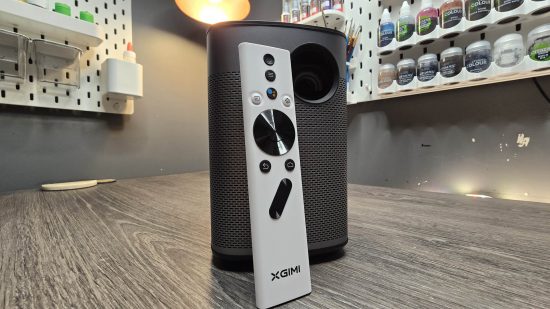
Should You Buy It?
- Yes: If you want an awesome, color-accurate, 1080p projector.
- Yes: If you travel a lot, and need something easy to use with apps.
- Yes: If you’re not looking to game on it.
- No: If you’re looking for a do-it-all gaming display
- No: If you want something bright
The XGIMI Halo+ might not have the crispest resolution, and the latency is lackluster when gaming over the HDMI port, but this is a phenomenal piece of kit. If you’re on the move, and like to enjoy your Netflix and YouTube content on the big screen, it’s epic. At $600 it’s a surefire pick, and only really beaten by the likes of the BenQ X3100i, a projector more than three as expensive
Alternatives
Verdict
You can pick up the XGIMI Halo+ Projector for around $650 at its cheapest. In fact, according to our sources, it’s even been seen as low as $600 around the Black Friday period. For that price, it’s an absolute steal, even if it’s only 1080p. In almost every other aspect, it’s close to darn-near perfect. Ok, it has some latency issues when it comes to gaming, and that can be challenging to deal with particularly if you’re trying to play competitively or like your RPGs Elden Ring flavored, but otherwise, this is a phenomenal projector.
